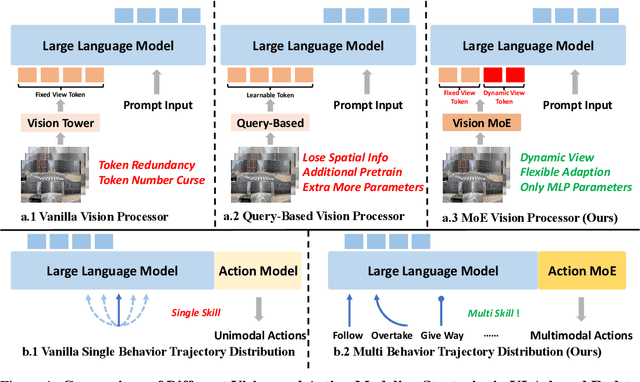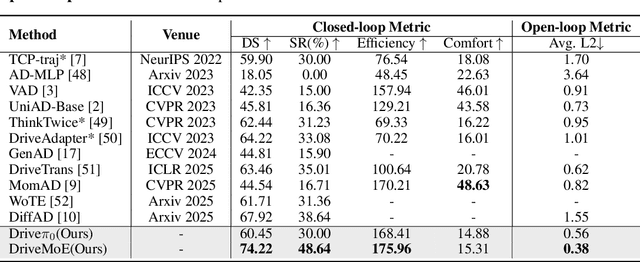Yuqian Shao
ReSim: Reliable World Simulation for Autonomous Driving
Jun 11, 2025Abstract:How can we reliably simulate future driving scenarios under a wide range of ego driving behaviors? Recent driving world models, developed exclusively on real-world driving data composed mainly of safe expert trajectories, struggle to follow hazardous or non-expert behaviors, which are rare in such data. This limitation restricts their applicability to tasks such as policy evaluation. In this work, we address this challenge by enriching real-world human demonstrations with diverse non-expert data collected from a driving simulator (e.g., CARLA), and building a controllable world model trained on this heterogeneous corpus. Starting with a video generator featuring a diffusion transformer architecture, we devise several strategies to effectively integrate conditioning signals and improve prediction controllability and fidelity. The resulting model, ReSim, enables Reliable Simulation of diverse open-world driving scenarios under various actions, including hazardous non-expert ones. To close the gap between high-fidelity simulation and applications that require reward signals to judge different actions, we introduce a Video2Reward module that estimates a reward from ReSim's simulated future. Our ReSim paradigm achieves up to 44% higher visual fidelity, improves controllability for both expert and non-expert actions by over 50%, and boosts planning and policy selection performance on NAVSIM by 2% and 25%, respectively.
DriveMoE: Mixture-of-Experts for Vision-Language-Action Model in End-to-End Autonomous Driving
May 22, 2025



Abstract:End-to-end autonomous driving (E2E-AD) demands effective processing of multi-view sensory data and robust handling of diverse and complex driving scenarios, particularly rare maneuvers such as aggressive turns. Recent success of Mixture-of-Experts (MoE) architecture in Large Language Models (LLMs) demonstrates that specialization of parameters enables strong scalability. In this work, we propose DriveMoE, a novel MoE-based E2E-AD framework, with a Scene-Specialized Vision MoE and a Skill-Specialized Action MoE. DriveMoE is built upon our $\pi_0$ Vision-Language-Action (VLA) baseline (originally from the embodied AI field), called Drive-$\pi_0$. Specifically, we add Vision MoE to Drive-$\pi_0$ by training a router to select relevant cameras according to the driving context dynamically. This design mirrors human driving cognition, where drivers selectively attend to crucial visual cues rather than exhaustively processing all visual information. In addition, we add Action MoE by training another router to activate specialized expert modules for different driving behaviors. Through explicit behavioral specialization, DriveMoE is able to handle diverse scenarios without suffering from modes averaging like existing models. In Bench2Drive closed-loop evaluation experiments, DriveMoE achieves state-of-the-art (SOTA) performance, demonstrating the effectiveness of combining vision and action MoE in autonomous driving tasks. We will release our code and models of DriveMoE and Drive-$\pi_0$.
 Add to Chrome
Add to Chrome Add to Firefox
Add to Firefox Add to Edge
Add to Edge